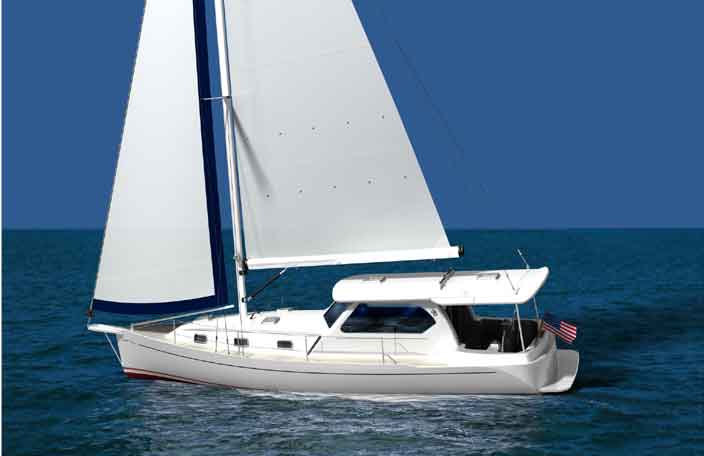Shannon 38 HPS Design Comment
by Walt Schulz

1. Design a boat that would actually sail to weather in 10 knots of breeze;
2. The boat would have a “sailing draft” (with no centerboard) of 3 feet for the ICW and Bahamas;
3. There would be an inside out-of-the- weather helm station and as well as outside helms with good visibility for nice weather steering;
4. The boat could cruise under power at 12 knots;
5. There would be the provision to have twin engines for mechanical redundancy;
6. The boat would be small enough so I could handle it alone docking or sailing; and
7. The interior would be big enough for my wife Janet and I to be comfortable aboard for extended periods. Obviously, the boat would also have to be rugged, seaworthy and ocean storm-ready because it is a Shannon.
Okay, so what’s all this about 12 knot cruising speed under power. I love to sail and have never lost my enthusiasm for wind propulsion. I have no problem sailing at 6 knots for days on end. But, the wind can be a finicky friend. If I’m pressed for time or trying to get somewhere before dark, I can always predict the wind direction and speed the day before. The wind will be blowing right from my planned destination at about 20 to 30 knots. Sure you can tack to windward doubling the distance watching the knot-meter drop to 4 knots or less whenever you hit a wave. As an aside, a truly wonderful feature of twin engines on a sailboat is that you can run the leeward engine to get significant lift and added power going to weather with ½ the fuel burn. If you don’t have twin engines, you can drop the sails and power right into the wind. But a seven knot sailboat sailing at an angle to the waves with reasonable speed in relative comfort quickly becomes a very slow boat punching into big head seas. Conversely, there is also the “Dead Sea Syndrome” where the total lack of wind misery is only matched by the baking heat. If you are going to the expense and maintenance issues of having an auxiliary engine in a sailboat in the first place, why not have a boat that will cruise at 12 knots under power? Spouse, family and guests will love the speedy conclusion to a day of foul winds or no wind.
So, how did I finally come up with the 38 HPS that actually sails to windward in 36 inches of water that cruises under power at 12 knots? Simply put, the 38 HPS is a modified and extended Shoalsailer 35 with my other patented SRD Technology powerboat aft sections. The important point is I’m using real sea-proven technology and not wishful thinking for the new design. I expect some people to consider the design to be “radical”. In a world where almost every automobile looks like a Toyota Camry and where the sailboat industry only builds 1970’s vintage fin keel sloops in the 21st century, any departure from the “pack” is somewhat heretical. Yet, it is a known fact that fewer people each year get into (and more importantly stay in) sailboats. Maybe the buyers are trying to tell the marine industry that they are tired of being cold, wet or hot in open cockpits or sitting under Dacron and plastic “cockpit chicken coops” to get out of the weather, all while struggling with winches on big head-sailed sloops making 6 knots. Sure, there have been some attempts at motorsailer designs, but the boats don’t sail very well (or not at all) and power very slow, while at the same time providing no cockpit, where everyone who has lived-aboard knows you spent 90% of the daylight hours. Remember, this 38 HPS design is by the same heretic that was the first to put lazy jacks on a fiberglass sailboat, bow thrusters, mainsail boom furling , radar in the cockpit, twin engines on the 53 HPS and a bunch of other so-called “radical” ideas at the time. Fortunately, we only build a limited number of boats each year so “mass market appeal” is never an issue at Shannon. And, I’m tired of talking to folks that had to give up the joy of sailing and end up buying inherently unsafe and painfully slow trawlers just to stay on the water.
A 37’ 9” the waterline was the right size to make the boat easy enough for me to handle alone when docking or sailing, yet provided enough accommodations and space for storage to keep both me and Janet happy. So here you have it – four years to answer the 7 questions that I believe is the ideal boat for both me and hopefully for some other sailors not ready yet for spending the rest of their lives being bored on the ICW while their trawler engine drones on, or enduring what’s left of retirement sitting on a park bench feeding the pigeons.
W.S.
| CUSTOM INTERIORS | EXTERIORS | RIGS & SAILS | WALT'S DESIGN COMMENT | BACK TO 38HPS | SPECIFICATIONS | |||||